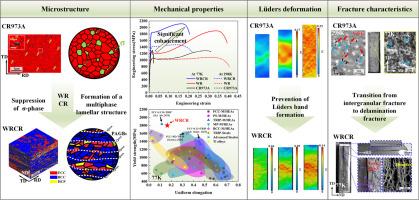多相层状结构亚稳高熵合金中优异的低温强度-延展性协同作用
IF 14.3
1区 材料科学
Q1 MATERIALS SCIENCE, MULTIDISCIPLINARY
引用次数: 0
摘要
深空探测需要在低温条件下具有超强强度和韧性的材料。在这项研究中,我们通过一种简单有效的两步连续轧制策略,即冷轧结合冷轧(WRCR),优化了亚稳Fe46Co30Cr10Mn5V5Si4 (at.%)高熵合金(HEA)的低温力学性能。该工艺提高了生产效率,同时将组织细化为多相片层结构,有效抑制了有害的σ相析出。经wrcr处理的合金具有优异的低温力学性能,屈服强度为1.8 GPa,极限抗拉强度为2.1 GPa, 77 K时均匀伸长率为16.8%。在高密度位错的驱动下,定制的相变动力学可以实现超高的YS,同时保持相变诱导塑性(TRIP)效应,从而提高低温下的延展性。此外,细化的片层结构促进了裂纹路径偏转和分层断裂模式,显著提高了抗断裂能力。可动位错和应变硬化之间的相互作用决定了屈服点行为,影响了应力降和本文章由计算机程序翻译,如有差异,请以英文原文为准。

Superior cryogenic strength-ductility synergy in a multiphase lamellar-structured metastable high-entropy alloy
Deep space exploration demands materials with exceptional strength and toughness under cryogenic conditions. In this study, we optimize the cryogenic mechanical performance of a metastable Fe46Co30Cr10Mn5V5Si4 (at.%) high-entropy alloy (HEA) through a simple and efficient two-step continuous rolling strategy that combines warm rolling with cold rolling (WRCR). This processing route enhances production efficiency while refining the microstructure into a multiphase lamellar architecture, effectively suppressing deleterious σ phase precipitation. The WRCR-processed alloy exhibits outstanding cryogenic mechanical properties, including a yield strength (YS) of 1.8 GPa, ultimate tensile strength of 2.1 GPa, and a uniform elongation of 16.8% at 77 K. Tailored phase transformation kinetics, driven by high-density dislocations, enable ultrahigh YS while sustaining transformation-induced plasticity (TRIP) effects, thereby enhancing ductility at cryogenic temperatures. Furthermore, the refined lamellar structure promotes crack path deflection and delamination fracture modes, significantly improving fracture resistance. The interplay between movable dislocations and strain hardening governs the yield-point behavior, influencing both the stress drop and the extent of Lüders band deformation. Notably, pre-activated dislocations and martensitic transformation in the WRCR sample effectively suppress Lüders band propagation. This work provides critical insights into the control of heterogeneous deformation and presents a scalable strategy for designing metastable HEAs with superior cryogenic performance.
求助全文
通过发布文献求助,成功后即可免费获取论文全文。
去求助
来源期刊

Journal of Materials Science & Technology
工程技术-材料科学:综合
CiteScore
20.00
自引率
11.00%
发文量
995
审稿时长
13 days
期刊介绍:
Journal of Materials Science & Technology strives to promote global collaboration in the field of materials science and technology. It primarily publishes original research papers, invited review articles, letters, research notes, and summaries of scientific achievements. The journal covers a wide range of materials science and technology topics, including metallic materials, inorganic nonmetallic materials, and composite materials.
 求助内容:
求助内容: 应助结果提醒方式:
应助结果提醒方式:


